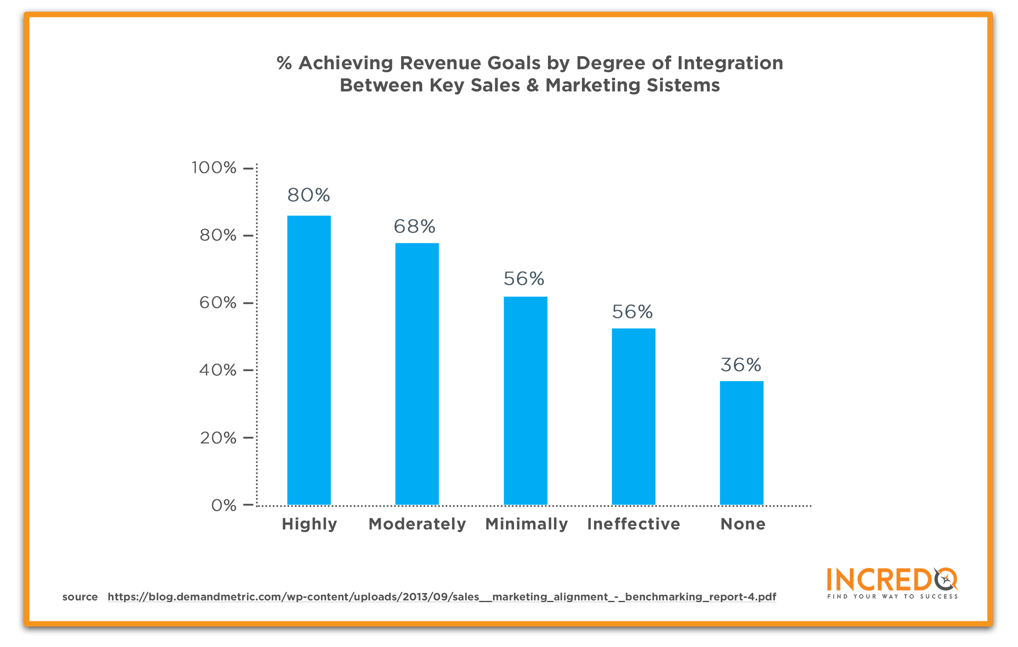Sales and marketing alignment is all about the customer.
Everything performed by these two teams needs to be done as if seen through the eyes of the customer, since in the end, that’s what really matters. None of your actions (even if they cost a ton of money or are just brilliant) matter a tiny bit, if they don’t resonate with customers.
WordPress
Given this, there are still many companies that believe in the perfect sales and marketing delineation. This is basically when the marketing team generates leads for sales, and then the sales team qualifies these leads in order to close them as customers.
However, that’s not how it works in today’s reality. The reason is that customers have changed more in the past 10 years than they have in the past 100 years. Customers are more connected, empowered and have practically unlimited access to information. To serve customers in the best possible way, sales and marketing teams need to be highly integrated and work together. To put it simply, the marketing team needs to understand more about the sales process, and vice versa.
According to a Demand Metric Benchmark Report on Sales and Marketing Alignment, about 65% of companies reporting complete alignment achieved their revenue goals compared to only 40% who reported no alignment. Furthermore, in the graph below we can see that highly integrated sales and marketing teams achieve their revenue goals by 50% more than non-integrated teams.
WordPress
In the case of SaaS, the cooperation between marketing and sales teams is even more important. Here, the marketing team needs to drive this alignment and serve two groups: the real customers and the sales team. Nothing can decrease your revenue more than misalignment and miscommunication!
So, here are 7 tips for how to achieve smooth cooperation between SaaS marketing and sales teams:
1. Implement closed-loop reporting
In your SaaS company, all of the important decisions must be made based on data and for this reason, there should be a strong alignment between your marketing software and CRM. It really does not matter which platform you are using, (Hubspot, Pardot, Marketo, Salesforce or other), you just need to make sure that you are able to track attribution from your first marketing touch through the funnel to a closed-won opportunity. In closed-loop reporting, the sales team reports to the marketing team what happened with the leads that they received, which helps marketers to understand which are their best and worst lead sources. Here is what closed-loop marketing looks like:
WordPress
Closed-loop reporting is beneficial for SaaS companies in a number of ways:
- Closed-loop reporting directs a company’s attention to the most important conversion channels. By having a chance to look at the offers/channels that traditionally brought customers to your company, you will be able to work more strategically in order to engage with new leads and put them in a sales funnel.
- The data gathered through closed-loop reporting is crucial. In this case, instead of relying on assumptions and theories, you can make decisions based on real data.
- It helps with creating buyer personas. Just because you can gain a 360-degree view of your sales cycle – looking at the user’s first visit to your website, browsing through their activities and identifying their last conversion event – you collect insights about the ideal prospect, which can help you in creating the right buyer personas for your SaaS company.
2. Assign a marketing qualified lead (MQL) commitment
An MQL is a lead that is more likely to become a customer compared to other leads based on lead intelligence. These leads are more interested in your products than others based on their activities, behavior, demographics, etc. Qualifications can include expressing interest by downloading an ebook, having certain professions, or website activities, like visiting the pricing page and so on.
“Great demand generation” marketers must be ready to manage a high number of marketing qualified leads at once. To manage everything correctly, when working through your annual sales planning, try and understand how many MQLs you need in order to reach your growth goals and establish marketing monthly targets.
For better planning and implementation, you can segment that data by MQL type (demo, contact sales, content download, etc.). Now, you have not only the number of MQLs, but also their status and sales opportunities. This is vital, because in this method, it will be much easier for the marketing team to nurture leads that have downloaded an ebook, differently than those who requested a demo.
3. Track the lifecycle stage
When you have established closed-loop reporting and MQL quotas, it’s important to keep track of your prospects in order to understand where they might be stuck and what needs to be done to make them happy. For this reason, you can make use of lifecycle stages and lead status to understand at which stage your contacts are at in the sales funnel. Here, it’s important to carefully assign the entry and exit criteria for each stage, so it’s clear when the lead should be moved to the next stage, when he/she should be removed or disqualified, and so on. Here are the main lifecycle stages a lead should go through in order to become a customer:
- Subscriber: These are the people who know about your company and have provided their email addresses in order to hear from you periodically.
- Lead: Leads are those who are more interested in your company and its products than subscribers. Leads usually fill out a form and give more information about themselves for specific purposes, such as downloading a white paper.
- Marketing qualified lead (MQL): These are the people who are more engaged, sales-ready contacts than your usual leads, but who have not yet become fully fledged opportunities.
- Sales qualified lead (SQL): These are those leads that your sales team has decided to follow up on and contact in order to close them as customers.
- Opportunities: Those are contacts that have become real sales opportunities in your CRM.
- Customer: This is the final and most desired stage. A stage where actual, paying customers arrive.
4. Create a lead hand-off process and define expectations
For smooth cooperation between SaaS marketing and sales teams, the MQL workflow needs to clearly show how a lead should be nurtured and passed from marketing to sales afterwards. This process should be shaped by data to find the optimal number of sales attempts needed per lead. In addition, the process must not only include the number of attempts that should be made in total, but also at which point the first attempt should be made.
To put it simply, you should be asking how long do you have to nurture a lead before you can try a sales call? And if the first call fails, how many more calls should be done before giving up? Use your customer data to make your estimations, and later tweak and turn it to reflect the reality as much as possible. Here is an awesome infographic telling us about the best time to call prospects, based on data from 100,000 calls.
5. Create a service-level agreement (SLA)
Nothing defines the responsibilities of SaaS sales and marketing teams better than a service-level agreement. This is a document showing how and when the marketing team should deliver qualified leads and how and when the sales team should close these leads as customers. This document makes processes much easier, shows where the teams are at in their working process, and when the company’s goals can be met.
6. Organize “Smarketing” meetings
For a smooth and healthy cooperation between the two teams, productive meetings are essential. Bring these two teams together regularly (but make sure that the meetings don’t turn into something obligatory with little to no effect), in order to review goals, discuss any current challenges, get updates and just help each other to reach the common company goals. While, nowadays, there is a culture of eliminating meetings, frequent smarketing meetings can help keep the lines of communication open. Organize a weekly 30-60 minute meeting that will include the entire sales and marketing teams, who will report their activities, discuss any present issues, work on their strategies and so on.
In the beginning, such meetings need to be interactive and should host many discussions between the teams. As the marketing and sales team alignment grows, the meetings should become more fast-paced and be based on the SLA.
7. Report the achievements
Though sales and marketing should always work together, sometimes they can feel like they are on separate islands. The two most common problems between these teams are:
- The lead quality problem: In this case, sales teams complain that marketing teams do not do their work properly and provide them with low qualified leads.
- The 2 teams have different views: Sometimes, sales and marketing teams have different views of what works, what doesn’t, which is usually the primary reason for conflicts.
To solve these problems, on a monthly basis, as a part of your sales and marketing reports, you need to highlight the part of the revenue that was influenced by the marketing team. This is an excellent way to show both teams how valuable the work of the marketing team really is. By presenting such reports, there will be much smoother cooperation between SaaS marketing and sales teams.
Bringing SaaS sales and marketing teams together sounds like a lot of work, and it is. However, it is a solid, successful foundation for your company’s development and future growth. Creating this alignment and fostering a data-driven marketing and sales culture from the beginning will absolutely deliver the expected results.
Do you have other tips-to-know to share with us? If so, please leave them in the comments below. We would be excited to hear from you!
Tags:
SaaS Growth
September 8, 2016



![Marketing and Sales Synergy Model for SaaS [2021]](https://incredo.co/hs-fs/hubfs/Imported_Blog_Media/How20Marketing-1.png?width=520&height=294&name=How20Marketing-1.png)
![5 Sales Strategies Mistakes Most of the SaaS CEOs Do [2021 GUIDE]](https://incredo.co/hs-fs/hubfs/Imported_Blog_Media/SaaS20Sales20Strategy-1.png?width=520&height=294&name=SaaS20Sales20Strategy-1.png)

Comments